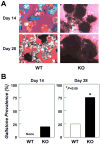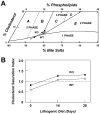Lack of endogenous cholecystokinin promotes cholelithogenesis in mice
- PMID: 26604077
- PMCID: PMC4760924
- DOI: 10.1111/nmo.12734
Lack of endogenous cholecystokinin promotes cholelithogenesis in mice
Abstract
Background: Celiac disease is an autoimmune enteropathy caused by a permanent intolerance to dietary gluten in genetically predisposed individuals. Cholecystokinin (CCK) release from the proximal small intestine and gallbladder emptying in response to a fatty meal are greatly reduced in celiac patients before they start the gluten-free diet, showing a genetic predisposition to gallstones.
Methods: To elucidate the complex pathophysiological mechanisms determining the biliary characteristic of celiac disease, we investigated the effect of the absence of endogenous CCK on cholesterol crystallization and gallstone formation in mice fed a lithogenic diet for 28 days.
Key results: Fasting gallbladder volumes were increased and the response of gallbladder emptying to the high-fat diet was impaired in CCK knockout (KO) mice compared to wild-type mice. Because of the absence of CCK, small intestinal transit time was prolonged and intestinal cholesterol absorption was increased. During 28 days of feeding, elevated biliary cholesterol concentrations and gallbladder stasis promoted the growth and agglomeration of solid cholesterol crystals into microlithiasis and stones. Thus, cholesterol crystallization and gallstone formation were accelerated in CCK KO mice. In contrast, daily intraperitoneal administration of CCK-8 reduced gallstone formation in CCK KO mice even on the lithogenic diet.
Conclusions & inferences: The lack of endogenous CCK enhances susceptibility to gallstones by impairing gallbladder contractile function and small intestinal motility function. These findings show that celiac disease is an important risk factor for gallstone formation and the gallbladder motility function should be routinely examined by ultrasonography and gallbladder stasis should be prevented in celiac patients.
Keywords: bile salt; celiac disease; cholesterol absorption; cholesterol crystallization; gallbladder motility; lithogenic bile.
© 2015 John Wiley & Sons Ltd.
Conflict of interest statement
Competing Interests: the authors have no competing interests.
Figures







References
-
- Kelly CP. Celiac Disease. In: Feldman M, Friedman LS, Brandt LJ, editors. Sleisenger and Fordtran’s Gastrointestinal and Liver Disease. 10. Vol. 2. Elsevier Saunders; 2014. pp. 1849–1872.
-
- Green PH, Cellier C. Celiac disease. N Engl J Med. 2007;357:1731–1743. - PubMed
-
- Farrell RJ, Kelly CP. Celiac sprue. N Engl J Med. 2002;346:180–188. - PubMed
-
- Vriezinga SL, Schweizer JJ, Koning F, Mearin ML. Coeliac disease and gluten-related disorders in childhood. Nat Rev Gastroenterol Hepatol. 2015;12:527–536. - PubMed
Publication types
MeSH terms
Substances
Associated data
- Actions
- Actions
- Actions
- Actions
- Actions
- Actions
- Actions
- Actions
- Actions
- Actions
- Actions
- Actions
- Actions
- Actions
- Actions
- Actions
- Actions
- Actions
- Actions
- Actions
Grants and funding
LinkOut - more resources
Full Text Sources
Other Literature Sources
Research Materials

